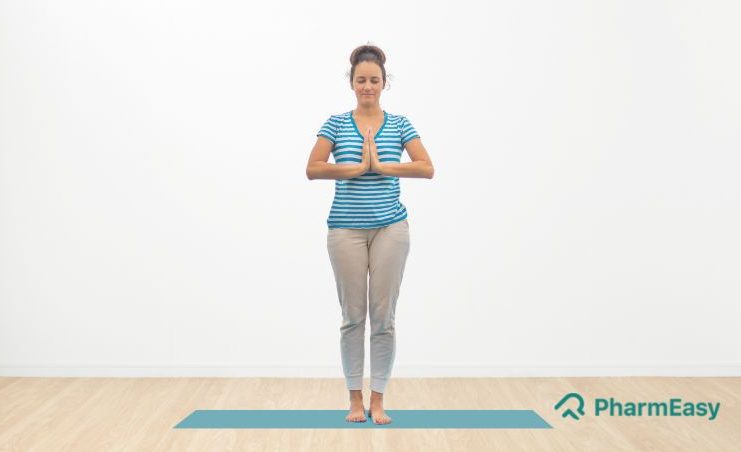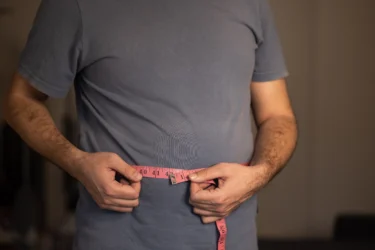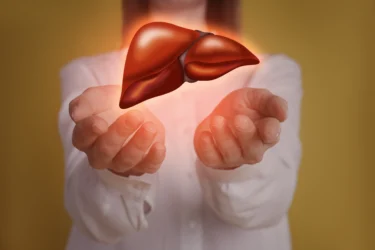Benefits of Pranam Asana (Prayer Pose) and How to Do it By Dr. Himani Bisht
By Dr. Himani Bisht +2 more

Get,

to manage your symptom
Get your,


4 Cr+ families
benefitted

OTP sent to 9988776655



You’ve successfully subscribed to receive
doctor-approved tips on
Whatsapp

Get ready to feel your best.

Hi There,
Download the PharmEasy App now!!


Register to Avail the Offer
Send OTPBy continuing, you agree with our Privacy Policy and Terms and Conditions

Hi There,
Sign up on PharmEasy now!!
Trusted by 4 crore+ families

OTP sent to 9988776655



You have unlocked 25% off on medicines




Code: NU25
By Dr. Himani Bisht +2 more
Table of Contents
“The longest journey of any individual is the journey inwards”. Yoga wants people to focus on their inner awareness. Surya Namaskar is a series of twelve yoga asanas performed in a dynamic and breath-synchronized manner. Form, energy and rhythm are the three main components of Surya Namaskar. In addition, the twelve asanas are believed to give rise to “Prana”, the subtle force that stimulates the body. When performed in a sequential, steady and rhythmic manner in synchronization with the circadian rhythm (sleep-wake cycle), the rhythm of the cosmos is reflected in these asanas1. One such asana in the Surya Namaskar series is Pranam asana, also known as the praying pose. Let us look at some exciting features and benefits beyond the mat of the praying pose.

Did You Know?
Pranam asana, also called the praying pose, is the entering/starting pose of Surya namaskar (Sun salutation). The name has roots in the Sanskrit word “Pranama” (pay respect) and “asana” (posture/pose). It is also called the praying pose because, in this asana, hands are held together in “Anjali mudra” or namaskar. This asana, which is part of the Surya namaskar series, was propagated by the King of Aundh, Late Shri. Balasaheb Pant (1920s) and later by Shri Krishnamacharya and Sri K V Iyer2.
Following are the steps to perform Pranam asana correctly to avail of maximum benefits:
As far as my knowledge goes, the immune system plays a crucial role in defending the body against disease-causing agents. One interesting observation is that when the Pranam Asana is combined with other steps of Suryanamaskar, it may potentially enhance the efficiency of the immune system. This may contribute to better immunity supporting your ability to protect against infections and illnesses8.
Dr. Rajeev Singh, BAMS
This classic namaskar asana pose is known to provide several benefits to the mind and body, which are described as under:

Kawaljeet et al. conducted a study3 in 2010 to assess the effect of a six-week consistent Surya namaskar practice for female students in the age group of 17-25 years. A significant improvement was seen in the flexibility, muscular endurance and posture of these participants. Yoga postures like Pranam asana may help improve postural alignment when practised as a part of Surya Namaskar4. However, please do not rely on Pranam asana alone in case of any suspected postural issues. So, kindly see a doctor for proper treatment. It is best to practice this under the guidance of a trainer.

Subhash et al. conducted a study4 in 2018 on 60 obese individuals to assess the effect of Surya Namaskar on obesity. Six weeks of regular Surya Namaskar practices showed a significant reduction in Body Mass Index, systolic and diastolic blood pressure, total cholesterol and LDL-cholesterol (bad cholesterol). Findings supported that Pranam asana can have a positive impact on obesity when practised as part of the Surya Namaskar series5. However, you should not rely on Pranam asana alone. You must consult your doctor for proper treatment of obesity. Additionally, it is advised to practice this asana under the supervision of a qualified trainer.

Mullerpatan et al. conducted a study9 in 2013 to assess muscle activity while performing the 12 poses of Surya Namaskar. Results found that different asanas cause the activation of several muscles of the upper and lower body. The Prayer pose, when performed with other poses of Surya namaskar causes activation of many muscles of the body.6 However, in case of any MSD (muscular system disorder) it is recommended to consult a physician for proper treatment and do not rely on Pranam asana alone. In addition, it is advised to perform this yoga under the guidance of a qualified trainer.

Dr. C.A. Kayelarasi et al. in 2019 conducted a study6 to assess the effect of yogasanas like Pranam asana on fat content in 40 subjects with non-alcoholic fatty liver disease, which is the accumulation of fat in the liver. The findings from abdominal sonography revealed decreased fat and restoration of liver function, which could be attributed to Pranam asana performed along with other postures of Surya Namaskar.7 However, Pranam asana alone should not be considered a substitute for modern medicine. Consult a doctor if you have any hepatic (liver) disease, and perform this asana only under the guidance of a qualified yoga trainer.

Yoga practice may help develop the mind and body; however, it is still not an alternative to modern medicine. Therefore, you must not rely on Yoga alone to treat any condition. Instead, please consult a qualified doctor who will be able to assess your condition correctly and advise accordingly. Moreover, it is necessary to practice and learn Yoga under the supervision of a trained yoga teacher to avoid any injuries.
According to what I’ve observed, Pranam Asana may offer several benefits. One of its primary advantages is that it might help establish a state of concentration and calmness. By assuming this pose, you may prepare your mind and body for your busy day ahead2.
Dr. Siddharth Gupta, B.A.M.S, M.D (Ayu)
The general risks associated with the prayer pose include:
Note- It is always recommended to perform the asanas under the guidance of a qualified and experienced teacher. Please consult a doctor or yoga specialist while performing the asanas in the above-listed conditions.
Also Read: Benefits of Rajakapotasana (King Pigeon Pose) and How to Do it By Dr. Himani Bisht
Pranam asana, also called the praying or prayer pose, is one out of the twelve asanas of Surya Namaskar (sun salutation). The name has roots in the Sanskrit word “Pranama” (pay respect) and “asana” (posture/pose). This asana pays homage to the Sun, the source of all life forms.
This is the entering position of Surya Namaskar, which is entered in a standing position, standing firmly on the ground. Bring the hands close to the Anahata chakra (heart’s centre). The mantra enchanted during this asana is the “Om Mitray Namaha”. The praying pose helps in improving posture, helps prevent diabetes and obesity, helps to reduce anxiety and stress and revitalizes the mind and body.
Pranam asana is derived from the Sanskrit words “Pranam” (to pay respect) and “asana” (pose)2. Hence, it is essentially termed the prayer pose.
It is advised not to eat anything before practising Pranam asana as it is followed by other poses which involve stretching and squatting, which may put pressure on the stomach and can lead to consequences like vomiting.
Following are the steps involved while performing Pranam asana:
Stand upright with your feet held together. Close your eyes.
Bring your hands together in “Anjali Mudra” (Namaste position) near the Anahata chakra (Heart’s centre).
Focus on your breathing.
Repeat this asana during the first and last step of Surya Namaskar2.
The praying pose might help in improving posture, may help prevent diabetes and obesity, may help reduce anxiety and stress, and might revitalize the mind and body. It can improve the breathing process and think along with possible help in spiritual healing, etc4,7.
In a series of twelve poses of Surya Namaskar, Pranam asana is performed twice i.e., during the first and last step (Step 1 and Step 12).
Disclaimer: The information provided here is for educational/awareness purposes only and is not intended to be a substitute for medical treatment by a healthcare professional and should not be relied upon to diagnose or treat any medical condition. The reader should consult a registered medical practitioner to determine the appropriateness of the information and before consuming any medication. PharmEasy does not provide any guarantee or warranty (express or implied) regarding the accuracy, adequacy, completeness, legality, reliability or usefulness of the information; and disclaims any liability arising thereof.
Links and product recommendations in the information provided here are advertisements of third-party products available on the website. PharmEasy does not make any representation on the accuracy or suitability of such products/services. Advertisements do not influence the editorial decisions or content. The information in this blog is subject to change without notice. The authors and administrators reserve the right to modify, add, or remove content without notification. It is your responsibility to review this disclaimer regularly for any changes.
Comments

Leave your comment...
You may also like
Comments